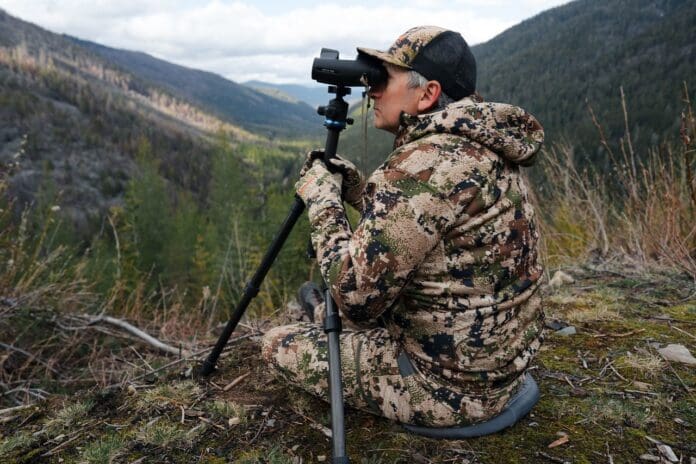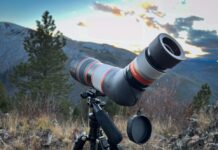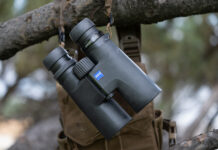
I’ve been a user of Leica optics for over twenty years, spending countless hours using their range finders, rangefinding binoculars, and spotting scopes. Their advancement in optical technology has been impressive to witness. In early 2022, Leica launched the Geovid Pro 8×32 and 10×32 models packed with new software and hardware. I was excited to give them a thorough test and review. They are the most compact rangefinding binoculars in Leica’s lineup and come equipped with Applied Ballistics software, Leica ProTrack software, and Bluetooth. Using the Bluetooth interface, hunters can transfer their ballistics profile from the new Leica Ballistics App to the Geovid Pro 32, while the ProTrack feature allows the user to locate on a map what was just ranged and then track directly to that location with their smartphone. More info here.

Leica Geovid Pro 32
The model tested was the 10×32 configuration. The Geovid Pro uses a Perger-Porro prism to rectify the image, which gives the barrels of the optic a slight bend and are of excellent optical quality. The shape of the Pro 32 is similar to the Leica Geovid HD-B, but the size is considerably smaller. It is close to the size of my old Leica Trinovid binocular, but with a weight of 29 ounces, is 3 ounces lighter. For reference, the 10×42 Rangefiding Binocular Geovids I currently own are 34 ounces. The glass is fully coated HD to maximize light transmission and produce accurate color rendering. The exit pupil of the 10x model is 3.2mm and the 8x model has an exit pupil of 4mm. The field of view (FOV) for the same models are 345 and 405 feet at 1000 yards. The complete list of specifications can be found here.
Ergonomics
The ergonomics of the binoculars are excellent. The barrels are slim and offer a solid hand wrap, and fit easily in a binocular pouch. I use a Sitka Mountain Optics Harness and the fit is superb. The eye cups twist out with eight different settings and, when tested, stay put. Although my style of glassing is to have the eye cups twisted to the lowest setting so there is never a problem in that area.
The focus wheel is exceptionally smooth and firm, allowing the optic to stay focused while riding in the binocular harness. Each eyepiece has individually adjustable diopters that are simple to adjust and have remained focused for the entire review process. The two rangefinder buttons are on the right side of the upper bridge hinge and are easy to reach and operate. One is convex, while the other is concave to differentiate between the two by touch.

Resolving Test
In addition to testing the binoculars in real-world conditions, they were tested using a USAF 1951 resolving power chart to determine how well the binoculars perform in daylight and fading evening light. The test started two hours before sunset in flat overcast light and finished about 45 minutes past sunset.
The 10×42 Geovids were used as a comparison during the test and both binoculars were mounted to tripods for a steady image. The glass on the Geovid Pro 32 is exceptionally clear and crisp, with beautifully rendered colors, and great edge-to-edge clarity. There is not any perceptible color fringing or distorted images coming from this glass.

Upon testing, I found the Geovid Pro 10×32 to have a sharper and clearer image (larger resolution values) than the Geovid 10×42 in regular light. However, around 30 minutes before sunset, both binoculars produced equal values, and as the light faded, the 10×42 started to outperform the Geovid Pros. This is due to the larger exit pupil (4.2mm) in the 10×42 binocular. It should be noted the difference was very marginal as the 32mm model was losing resolution about 3 minutes ahead of the 42mm binocular, and both resolved the thicker lines on the chart 36 and 39 minutes beyond the official sunset. In practical terms, the Geovid Pro can be used up to last light without the worry of missing most details.

Field Of View
One area of hesitation a lot of hunters have with a 32mm objective lens binocular is a smaller field of view than something in the 42mm range. As mentioned earlier, the 10×32 model has a FOV of 345 feet at 1000 yards, while the 10×42 has a FOV of 374 feet. The difference of 29 feet on paper seems insignificant, but, in the field, I found it noticeable. It was most apparent when the binoculars are used to cover vast amounts of mountainsides methodically. Glassing this spring for black bears, I noticed the difference in viewed area and occasionally longed for the larger FOV 10x42s. Up close work such as glassing animals in heavy timber, watching animals at long range or ranging targets, it wasn’t as noticeable.
The Bottom Line
If FOV is more important than the size and weight of the binocular, then a 42mm or larger optic would be the obvious choice. Otherwise, the lighter, more compact 32mm model may be worth the reduced FOV. Another option would be to choose the 8x model and have an increase in FOV and an increase in low light transmission with the drawback (for some users) of a lower power optic.

In Use at Total Archery Challenge
When using the binoculars for archery, I tend to range objects with one hand, which at 10x can be difficult if the target is small and the gap is tight. At the Big Sky leg of the Total Archery Challenge, I used the 10×32 Pro as my primary rangefinder. This event is well known for its tight gaps between trees and over logs and I found many of the targets hard to range with one hand. The 10x were a little shaky in this setting and an 8x optic would be better suited. This is something dedicated archers may want to think about when looking at ranger finding binoculars. It should be noted the angle-compensated range values generated in the Geovid Pro were spot-on for every target at the event.

Ballistic Solutions
The Geovid Pro range finder, built-in sensors, and internal software are powerful and extremely accurate. The laser easily returned ranges from large targets out to 2200 yards and animals at 2000 yards. The built-in compass, air pressure, temperature, and angle sensor worked seamlessly in the background to provide the Applied Ballistic (AB) Ultralight software with accurate results for my rifle and load profiles.
A drawback to the Ultralight version is it only provides solutions to 875 yards which can be inconvenient to shooters wanting to shoot longer ranges. The software can be upgraded to the Elite version for an extra $150.00. That allows for solutions at any distance that are ranged. If available, a workaround is to pair the binoculars with a Kestrel wind meter with Applied Ballistics. When utilizing a Kestrel, it paired extremely fast and provided accurate solution readouts seamlessly in the optic. Verifying this multiple times, all of the onboard sensors mirrored the environmental readings of my Kestrel 5700 Elite.
Leica Pro Track
The Leica Pro track feature allows the user to place a waypoint in Basemap (as well as Google maps and Garmin) by ranging a target in the distance. It plots it using the distance, angle, and direction of the ranged object. I tested this feature as often as I could and found it to be accurate more often than not. The steps to complete the process are a little convoluted but can be easily repeated once it’s been done a few times. Utilizing this feature can be incredibly useful to plan stalks or recover animals that have been shot at longer distances.
Leica Ballistic App
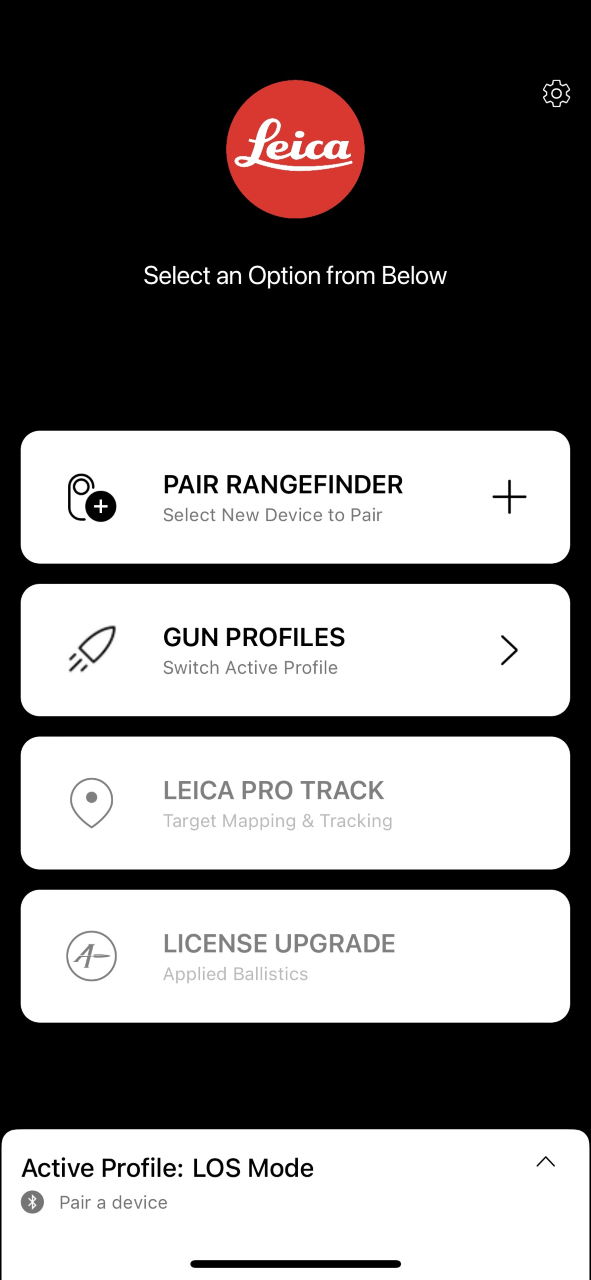
The app used to create and upload ballistic profiles is the new Leica Ballistic app. It pairs with the binocular via Bluetooth, and gun profiles are created and activated in the optic seamlessly as long as the Bluetooth is activated. Once the profile is loaded, I would recommend turning the Bluetooth off to save battery life and eliminate the flashing icon in the optic.
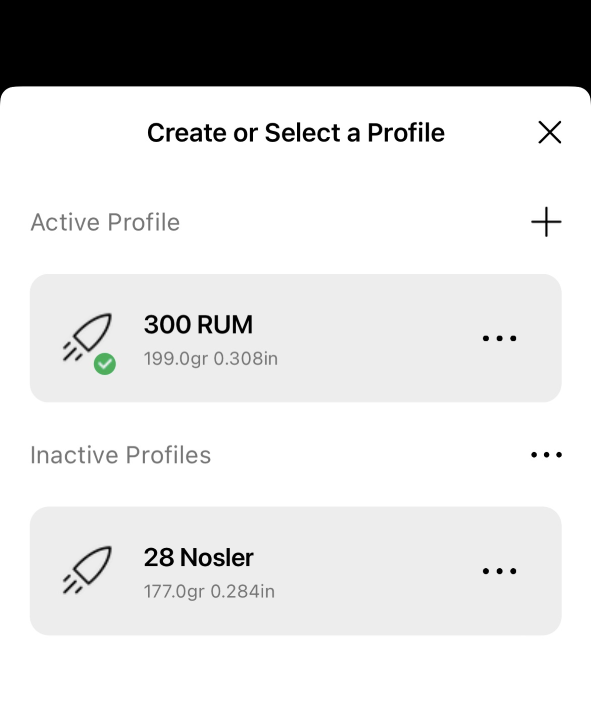
Wind Values and Adjustment
The Geovid Pro has the ability to input wind speed and direction. The speed values are zero through forty miles per hour. The wind direction values are whole hour values (12 o’clock, 1 o’clock, etc.). Each value has to be cycled up to the desired number and then selected. I practiced using the function several times in the field without any tutorials. Turns out it wasn’t easy to remember the steps, and I got a little confused at times. On the other hand, pairing the device to a Kestrel is simple and will give the user a quicker and perhaps more accurate wind call and is highly recommended if available to the user.

Overall
The Geovid Pro 32 is an excellent range-finding binocular loaded with incredible technology. The ergonomics are spectacular, with the overall smaller size and lighter weight. It is robust and waterproof with tack-sharp glass. Although the low light performance isn’t on par with larger optics, it does not lag very far behind.
The onboard sensors and laser are excellent and accurate, while the Applied Ballistic software is a major upgrade over Leica’s previous software. There are a few drawbacks, such as the extra fee for the Elite version of AB as well as the smaller FOV of the 32mm objective lens. The menu is a little awkward when changing between settings or adding wind values.
Leica Geovid Pro 32 Verdict
The new app is easy to use, works seamlessly, and stays connected when needed. This binocular is a great compromise between weight/bulk and optical performance (FOV and low light). It’s perfect for the hunter (rifle and archery) who doesn’t need to maximize either of these and wants a great all-around optic with advanced technology. The Geovid Pro 32 saves you noticeable weight and bulk over previous generation optics and competitors. This is a binocular that does well in almost every situation. Check out the Leica website for more.
Comment or ask Josh questions here.
Continue reading our other optics reviews here.














